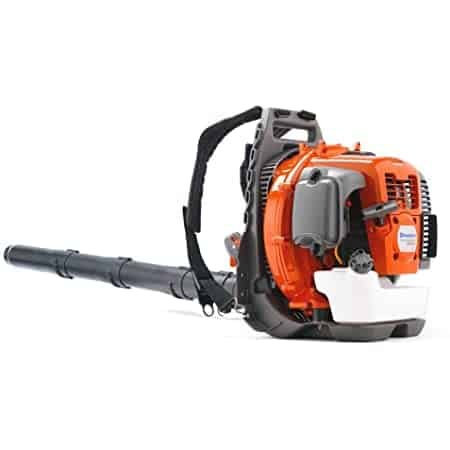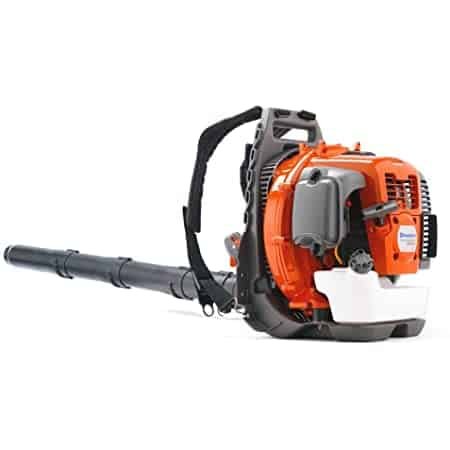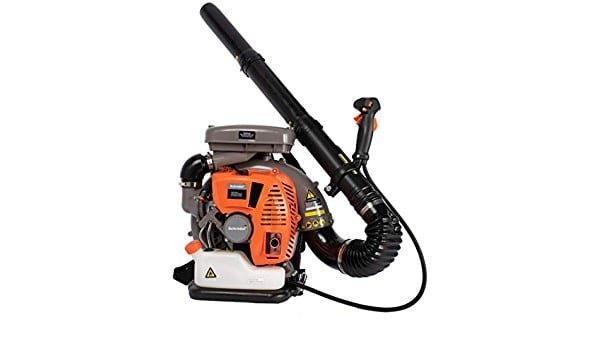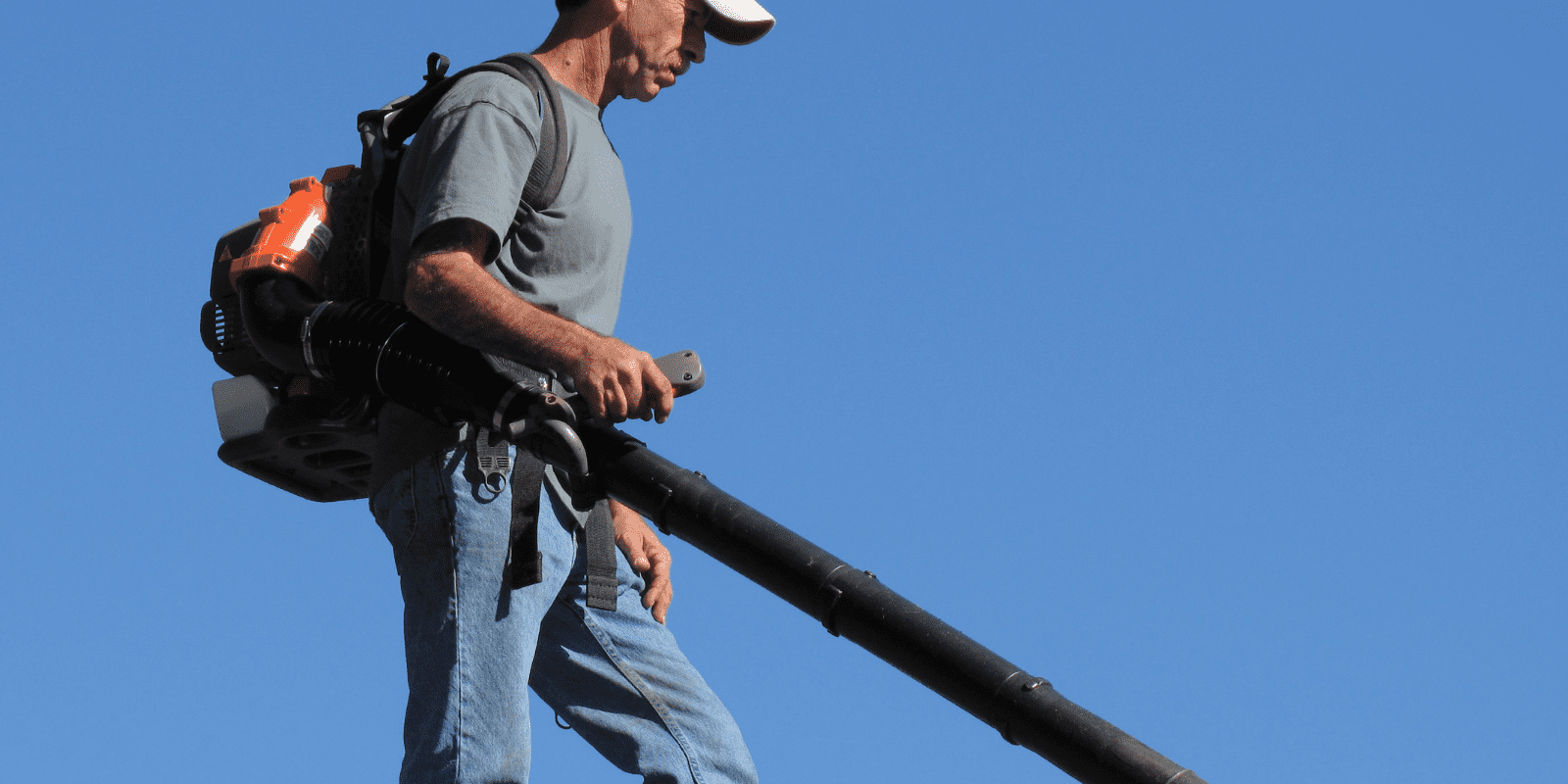Keeping your yard clean is a breeze with a backpack leaf blower.
Leaves, grass clippings, dust, and other debris are easily removed from your property by these professionals.
Even your gutters can be cleaned using leaf blowers with adaptor pipes.
A leaf blower can help you save time on yard work.
There are so many leaf blower models on the market, however, that deciding which one to buy can be tricky.
“Backpack blowers are more powerful and versatile than handheld blowers. They easily remove matted, wet leaves from hard-to-reach areas like foundation plantings and fence corners. They can also be used to keep rain gutters clean.”
Mark Wolfe – Writer
Whether you want a leaf blower with low emissions, high air velocity…
…or the lowest amount of noise, we have one to meet your needs.
Here are the best backpack leaf blowers in various categories.
Before we get to the top tools, let’s look at some of the considerations that made them the best…
What to Consider When Choosing the Best Backpack Leaf Blower

When shopping for a new leaf blower, there are several considerations to keep in mind.
Ideally, it should be powerful enough to clear debris and have enough power…
…(in the battery or in the fuel tank) to do the whole yard.
Below, we’ll take a close look at these and other essential shopping considerations.
Yard Size
A gas-powered blower is the best choice for large properties with leafy trees, lots of grass, outbuildings…
…and other areas that need detailed cleaning.
Blowers with long run times move debris farther and faster than models with shorter run times.
The blowers are also more efficient because users do not have to stop their work to refuel or replace their batteries.
Consider a lightweight, battery-powered blower if you have a smaller property…
…or only need to blow leaves off the sidewalk, the patio, or the driveway.
Power Source and Run Time
Volts (V) are used to measure battery power. In light-duty applications…
…battery-powered blowers have a maximum run time of about 1.5 hours.
The blower can be operated for as little as 10 to 15 minutes with heavy-duty blowing.
Gas-powered blowers are only limited by the size of their fuel tanks.
Engines are measured in cubic centimeters (cc).
The tanks of most gas blowers hold enough fuel to run at high power for 1.5 to 3 hours.
2-Cycle vs. 4-Cycle Engine
Blowers powered by gasoline usually have a two-cycle or four-cycle engine.
A 2-cycle engine produces a power stroke with one crankshaft revolution…
…whereas a 4-cycle engine produces a power stroke with two crankshaft revolutions.
A 2-cycle engine produces more power than a 4-cycle engine of the same size.
2-cycle engines require a fuel mixture of gas and oil to power and lubricate the engine at the same time…
…while 4-cycle engines run on gasoline and have a separate oil reservoir to lubricate the engine.
In general, efficient 2-cycle engines produce more power than 4-cycle engines of the same size…
…but clean-running 4-cycle engines emit fewer emissions.
Keep reading…
Air Volume and Speed
The air volume, measured in cubic feet per minute (CFM)…
…and the air speed, measured in miles per hour (MPH)…
…are the two best ways to determine a leaf blower’s performance.
Air volume measures the amount of air moving through the machine…
…while air speed measures how fast it moves. CFM is a better indicator of leaf-moving ability.
Blower manufacturers list the maximum CFM and MPH values on their product labels…
…but the speed at which they function depends on the user.
The power settings of backpack blowers are controlled using a trigger or a lever.
To reach the product’s maximum CFM and MPH ratings, you must run the machine at full power.
A blower with a capacity of 400 CFM is sufficient for cleaning hard surfaces like driveways and patios.
For large properties with significant lawn and leaf areas, use a 500-700 CFM blower.
Weight
Some battery-operated backpack leaf blowers weigh as little as 15 pounds…
…while their gasoline-powered counterparts weigh about 10 pounds more.
On large properties where leaf blowing can take an hour or more, weight certainly affects comfort.
The weight of a leaf blower usually correlates with its power…
…so it’s not always wise to choose the lightest model.
Choose a blower with an ideal combination of light weight and high power.
Comfort Features
The user’s comfort minimizes fatigue and reduces the chance of injury.
User comfort can be affected by the leaf blower’s size, harness system, hand controls, and tube.
A machine’s overall dimensions should correspond to the size of the user’s body.
While a tall and heavy user can operate any size blower…
…an operator with a smaller frame would be most comfortable with a compact blower.
The leaf blower’s harness system should include an adjustable waist strap…
…adjustable shoulder straps, and a sternum strap for added stability and balance.
At the elbow, the tube should flex and rotate comfortably.
Single-handed operation requires controls that are sensitive enough to work smoothly.
Noise
The average backpack leaf blower has a decibel rating of 95 to 105 (dB), measured at the user’s ear level.
While operating a leaf blower, it is important to wear earplugs or over-ear protection to prevent hearing loss.
It is important to check your local laws before purchasing a new blower…
…as some municipalities have noise ordinances that limit how loud machinery can be.
Low-noise backpack leaf blowers are available on the market…
…that operate at between 58 and 70 decibels and are powerful enough to accomplish the job.
Accessories
While operating a blower, there are several safety accessories that minimize the risk of injury.
In addition to hearing protection, leaf-blower manufacturers…
…and OSHA recommend wearing safety glasses to protect the eyes.
With a high-visibility safety vest, hat, and/or gloves, users working near streets…
…and sidewalks can be seen by approaching traffic.
Additional useful accessories include extra batteries for cordless electric blowers….
…and a spark plug wrench and fuel funnel for gasoline-powered blowers.
Before we get into the main part, let’s hear a few words from James…
My handheld blower took me more than 3 hours to use during the fall clean-up,
so I purchased this backpack leaf blower for the following weekend.
It has been a great purchase for me. In less than 15 minutes, I had assembled the machine and it was running.
A huge amount of dirt and debris was cleared in under an hour using this machine.
I found the backpack very comfortable, I experienced no fatigue, and it works well.
It is worth spending a little more money to get a tool that makes your work more enjoyable and easier.
It’s time for the main part…
Our Top Picks for Backpack Leaf Blowers
| Image | Title | Price | Prime | Buy |
|---|---|---|---|---|
 Top
Top | Husqvarna 360BT Backpack Blower, Orange | PrimeEligible | Buy Now | |
 Top
Top | Makita EB5300TH 52.5 cc MM4 4-Stroke Engine Tube Throttle Backpack Blower | PrimeEligible | Buy Now | |
 Top
Top | Greenworks Pro 80V (180 MPH / 610 CFM) Cordless Backpack Leaf Blower, 2.5Ah Battery and Charger Included BPB80L2510 | PrimeEligible | Buy Now | |
 Top
Top | Schröder Leaf Blower - Schröder Backpack Blower - Gas Leaf Blower - SR-6400L - 3.7 HP Engine - 5 Year Warranty | Prime | Buy Now |
Let’s go through them one by one…
Husqvarna 360BT Backpack Blower

- X-TORQ ENGINE: The X-Torq engine design reduces harmful exhaust emissions by up to 60 Percent and increases fuel efficiency by up to 20 Percent
Prices pulled from the Amazon Product Advertising API on:
Product prices and availability are accurate as of the date/time indicated and are subject to change. Any price and availability information displayed on [relevant Amazon Site(s), as applicable] at the time of purchase will apply to the purchase of this product.
Clean up medium and large properties with the Husqvarna’s power and air-moving ability.
In addition to its heavy-duty cleaning capabilities, the 65.6 cc…
…2-cylinder X-torque engine pushes 631 CFM at 232 MPH. It weighs 23.2 pounds.
By preventing the arm from being pulled downward, an offset handle makes controlling blow force easier.
A contoured and fully adjustable shoulder strap and waist strap allow the operator…
…to customize the fit for greater comfort and balance.
A Husqvarna X-Torq engine provides 2-cycle power with improved fuel economy and reduced exhaust emissions.
For easy starting, the air purge feature removes air from the carburetor and fuel system.
Pros
- Improved fuel economy with a 2-cycle gas-powered engine.
- Compared to other gas-powered blowers, it emits less exhaust.
- Offset handle makes it easier to control.
- Straps are adjustable to match body size and balance.
Cons
- A little hefty, weighing 23.2 pounds
- 2-stroke engine can be loud
Makita EB5300TH 4-Stroke Engine Backpack Blower

- Mechanical automatic engine decompression for quick and easy starts
Prices pulled from the Amazon Product Advertising API on:
Product prices and availability are accurate as of the date/time indicated and are subject to change. Any price and availability information displayed on [relevant Amazon Site(s), as applicable] at the time of purchase will apply to the purchase of this product.
With a 52.5 cc, 4-cycle engine that only runs on gasoline…
…the Makita produces cleaner emissions than 2-cycle engines.
Up to 516 CFM of air is pushed at a velocity of 184 MPH, resulting in strong cleaning ability.
With a 70 dB noise level, it is significantly quieter than its competitors, who average 95-105 dB. It weighs 26.5 pounds.
It features mechanical engine decompression for fast, easy starts…
…and a large air filter that can be easily replaced as needed.
Adjustable shoulder straps allow the operator to customize the fit.
With tool-less handle adjustment, the operator can quickly change the handle position for maximum efficiency.
Pros
- No special fuel required thanks to the 4-cycle engine.
- It runs at 70 decibels, much quieter than most other blowers.
- It’s easy to start as well.
- Adjustable shoulder straps for a custom fit.
Cons
- Weighs more than most backpack blowers at 26.5 pounds
- 4-cycle engine not as powerful as comparable 2-cycle engines
Go on…
Greenworks Pro 80V Cordless Backpack Leaf Blower

- Up to 18 minutes of continuous runtime on high speed with fully charged 80V 2.5Ah battery
Prices pulled from the Amazon Product Advertising API on:
Product prices and availability are accurate as of the date/time indicated and are subject to change. Any price and availability information displayed on [relevant Amazon Site(s), as applicable] at the time of purchase will apply to the purchase of this product.
For smaller gardens, the Greenworks Pro 80V Cordless Backpack Leaf Blower is a powerful…
…clean-operating leaf blower. Powered by an 80V lithium-ion rechargeable battery…
…it delivers up to 580 CFM at 145 MPH. The unit weighs just 14.64 pounds.
Brushless motors provide gas-equivalent performance and up to 1.5 hours of runtime per charge on low power.
On-demand power can be delivered through a variable-speed trigger and turbo button.
Operator fatigue can be reduced with cruise control. Padded shoulder straps provide additional comfort.
A 2.5 Ah battery and charger are included.
Pros
- Powered by 80-volt lithium-ion rechargeable batteries
- Weighs less than 15 pounds
- Turbo button for on-demand power burst
- Cruise control option to reduce operator fatigue
Cons
- Designed for small yards and short runtime (13 to 18 minutes)
Schröder Industrial Backpack Leaf Blower

- ? Best seller leaf blower : Schroder USA has the leading backpack leaf blower for both individuals and businesses. This commercial leaf blower will be the last leaf blower you will ever need.
Prices pulled from the Amazon Product Advertising API on:
Product prices and availability are accurate as of the date/time indicated and are subject to change. Any price and availability information displayed on [relevant Amazon Site(s), as applicable] at the time of purchase will apply to the purchase of this product.
The Schröder is powered by a strong 63.3 cc, 2-cycle engine with a 50:1 fuel ratio.
With only 19.5 pounds, this unit can push 920 CFM of air at a velocity of 230 MPH-enough power…
….to move heavy, wet leaves and other hard-to-move landscape debris.
The kit includes two blower tube extensions – one with a round outlet and the other with a flat outlet…
…and a carburetor tool for fine-tuning.
Pros
- Strong, 2-cycle engine
- Powerful blower for large yards and even wet leaves or debris
- Includes two blower tube extensions
- Weighs just 19.5 pounds
Cons
- More power than needed for small yards
- Engine requires 50:1 mix
Sum Up!
Yard cleanup is easy and fast with a backpack leaf blower.
There are gas-powered and battery-powered models available.
As well as average runtime, we took yard size into account, which matters more or less.
Cycle of the engine affects power and fuel mixture; 2-cycle engines require a special fuel mixture.
For efficient blowing of leaves and debris, air volume and speed were considered…
…and noted if either was lower or higher than average.
We considered features like strap adjustment and throttle control…
…as well as weight and weight when “wearing” a blower outdoors.
In addition, we looked for blowers that were not too noisy and had decibel levels within or below average.
Conclusion
Gas-engine backpack leaf blowers from Husqvarna are plenty powerful…
…with plenty of blowing capacity and convenient features that are designed to make your work easier.
Greenworks’ relative blowing power is beneficial to those with smaller yards…
…who prefer a more clean-running, battery-powered alternative.





